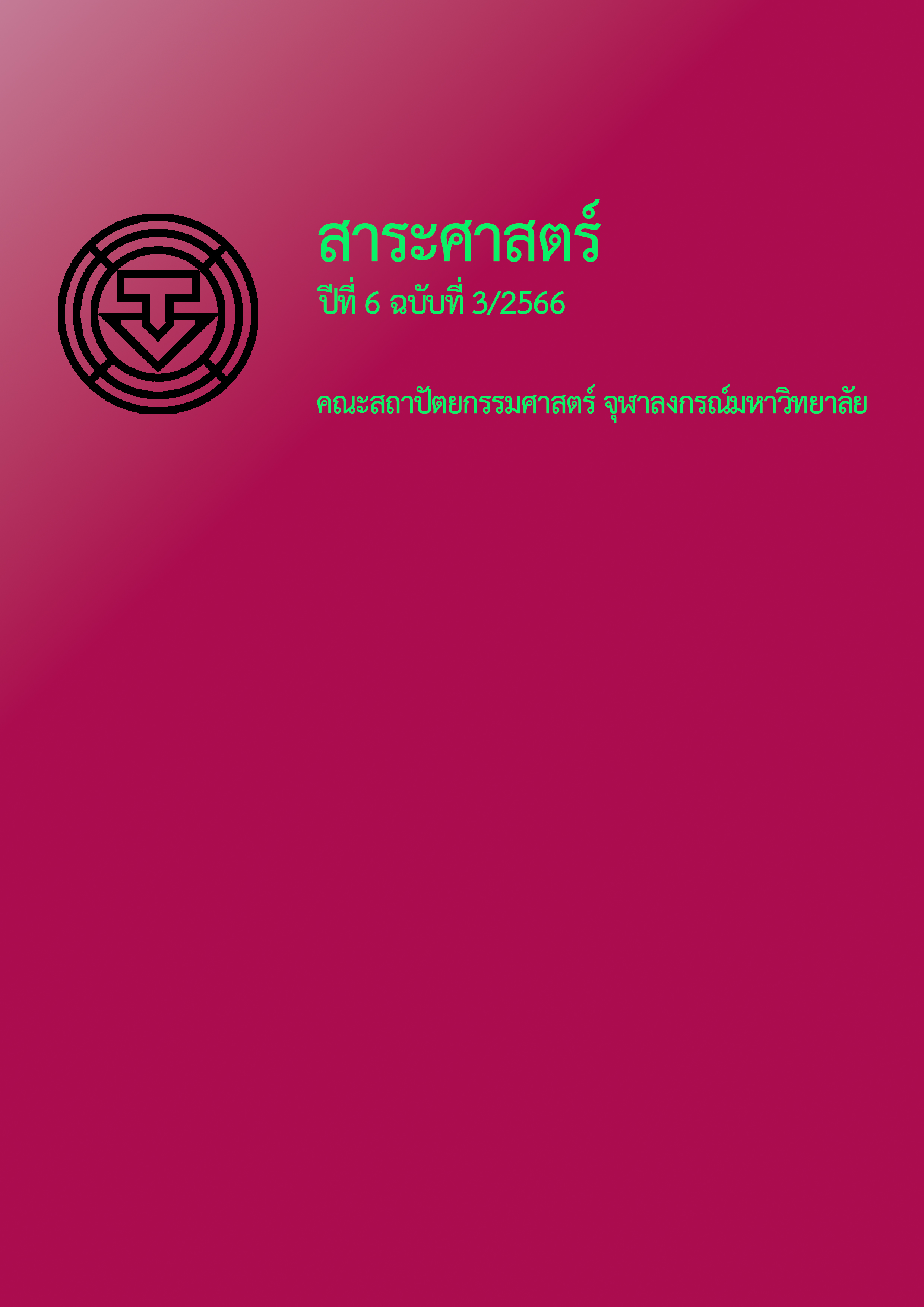แนวทางการส่งเสริมการใช้จักรยานสาธารณะปันปั่นสำหรับผู้อยู่อาศัยในอาคารชุดบริเวณรอบสถานีรถไฟฟ้าขนส่งมวลชน : ย่านสุขุมวิท
Main Article Content
บทคัดย่อ
จักรยานสาธารณะ เป็นการให้บริการจักรยานในลักษณะให้เช่า เพื่อสนับสนุนการเดินทางแบบไม่ใช้เครื่องยนต์ กรุงเทพมหานคร (กทม.) ได้เปิดให้บริการจักรยานสาธารณะที่เรียกว่าโครงการจักรยานสาธารณะปันปั่น หรือจักรยานปันปั่น เพื่อส่งเสริมการใช้จักรยานเชื่อมต่อกับสถานีรถไฟฟ้า แต่โครงการนี้มีข้อจำกัดในการขยายผลไปในเขตอื่น ๆ ตามที่กำหนดไว้ในแผนการส่งเสริมจักรยานปันปั่นระยะที่ 1 ดังนั้น เพื่อให้โครงการมีความยั่งยืน กทม. จะต้องมีพันธมิตรที่เข้ามาร่วมดำเนินการต่อยอดโครงการไปยังพื้นที่ต่าง ๆ โดยเฉพาะในย่านที่ประชาชนมีความต้องการ และสามารถใช้จักรยานเดินทางเข้าถึงสถานีรถไฟฟ้าได้สะดวก อย่างเช่น ย่านสุขุมวิทซึ่งถือเป็นย่านเป้าหมายหลักที่ กทม. ต้องการให้มีส่วนต่อขยายของโครงการจักรยานปันปั่นเกิดขึ้น งานวิจัยนี้มีวัตถุประสงค์ เพื่อศึกษาความเป็นไปได้ของการส่งเสริมการใช้จักรยานปันปั่นสำหรับผู้อยู่อาศัยในอาคารชุดย่านสุขุมวิท เพราะ 1) อาคารชุดเป็นที่อยู่อาศัยที่มีประชากรหนาแน่น 2) ย่านสุขุมวิทมีอาคารชุดจำนวนมาก และเป็นที่ตั้งของสถานีรถไฟฟ้าหลายแห่ง แต่ยังไม่มีสถานีบริการจักรยานปันปั่น 3) ย่านสุขุมวิทอยู่ในเขตวัฒนาและคลองเตยซึ่งอยู่ในแผนการส่งเสริมฯ ของ กทม. และ 4) มีความเป็นไปได้ที่ กทม. จะเป็นพันธมิตรกับนิติบุคคลอาคารชุดในการให้บริการจักรยานปันปั่นเพิ่มขึ้นจากเขตพื้นที่ให้บริการระยะแรก โดยผู้วิจัยได้ศึกษาวิธีการเดินทางของผู้อยู่อาศัยในอาคารชุด ปัญหาของการใช้จักรยานในชีวิตประจำวัน ประกอบกับความต้องการใช้จักรยานปันปั่น และแนวทางการส่งเสริมการใช้จักรยานปันปั่น จากการสำรวจพื้นที่ การสัมภาษณ์ผู้บริหาร กทม. และผู้ให้บริการจักรยานปันปั่น รวมทั้งการแจกแบบสอบถามแก่ผู้อยู่อาศัยในอาคารชุด ผลการศึกษาที่สำคัญพบว่า ผู้ตอบแบบสอบถามร้อยละ 61 จะใช้จักรยานปันปั่นเพื่อเข้าสู่สถานีรถไฟฟ้าหากมีสถานีบริการใกล้ที่พัก และร้อยละ 79 จะเดินทางเข้าสู่สถานีรถไฟฟ้าด้วยจักรยาน หากมีการปรับปรุงสิ่งอำนวยความสะดวกในการใช้จักรยาน ซึ่งผู้ตอบแบบสอบถามให้ความสำคัญกับความปลอดภัยในการเดินทางมากที่สุด ดังนั้น นอกจากการเพิ่มสถานีบริการจักรยานปันปั่นตามสถานีรถไฟฟ้าและอาคารชุดแล้ว กทม. ยังควรร่วมมือกับทุกภาคส่วนที่เกี่ยวข้องในการปรับปรุงสิ่งอำนวยความสะดวก และสภาพแวดล้อมให้ปลอดภัยต่อผู้ใช้จักรยาน เพื่อส่งเสริมการใช้จักรยานปันปั่นในพื้นที่ศึกษา
Article Details
เอกสารอ้างอิง
กระทรวงคมนาคม. สำนักงานนโยบายและแผนการขนส่งและจราจร. (2559). คู่มือมาตรฐานการออกแบบการก่อสร้างทางจักรยานสำหรับประเทศไทย. http://www.otp.go.th/ uploads/tiny_uploads/PolicyPlan/2-SafetyPlan/25590912-StandardBicycle.pdf
จักรพิพัฒน์ อัศวบุญญาเลิศ. (2556, 17 เมษายน). ทำไมคนไทยจึงไม่นิยมใช้จักรยาน. การประชุมวิชาการ “การส่งเสริมการเดินและการใช้จักรยานในชีวิตประจำวัน ครั้งที่ 1: 1st Bike and Walk Forum.” อาคารศูนย์เรียนรู้สุขภาวะ (สสส.), กรุงเทพมหานคร.
ชูสิทธิ์ ลิขิตมั่นชัย. (2558). มาตรการทางกฎหมายเพื่อสนับสนุนวัฒนธรรมการใช้จักรยานในเขตกรุงเทพมหานคร [วิทยานิพนธ์ปริญญามหาบัณฑิต ไม่ได้ตีพิมพ์]. มหาวิทยาลัยธรรมศาสตร์.
ธีรวุฒิ เอกะกุล. (2543). ระเบียบวิธีวิจัยทางพฤติกรรมศาสตร์และสังคมศาสตร์. สถาบันราชภัฏอุบลราชธานี.
นรุตม์ พูลรส. (2559). รูปแบบการใช้ประโยชน์ที่ดินและการเดินทางเข้าถึงสถานีของผู้อยู่อาศัยในอาคารชุดรอบสถานีรถไฟฟ้า [วิทยานิพนธ์ปริญญามหาบัณฑิตไม่ได้ตีพิมพ์]. จุฬาลงกรณ์มหาวิทยาลัย.
บุญธรรม กิจปรีดาบริสุทธิ์. (2547). ระเบียบวิธีวิจัยทางสังคมศาสตร์ (พิมพ์ครั้งที่ 8). จามจุรีโปรดักท์.Positioning Magazine. (2013). โครงการจักรยานสาธารณะปันปั่นฯ เปิดให้บริการ 12 สถานี เริ่ม 1 พ.ค. นี้. https://positioningmag.com/56360
มหาวิทยาลัยเกษตรศาสตร์. คณะสถาปัตยกรรมศาสตร์. (2558). โครงการปรับปรุงเส้นทางจักรยานชุมชนเพื่อสภาวะแวดล้อมที่ดีในเขตกรุงเทพมหานคร – กลุ่มกรุงเทพฯ เหนือ (รายงานวิจัย). คณะ.
วิติยา ปิตตังนาโพธิ์. (2556, 17 เมษายน). แรงจูงใจและอุปสรรคในการใช้จักรยานสาหรับคนที่เดินทางด้วยจักรยานในประเทศไทย. การประชุมวิชาการ “การส่งเสริมการเดินและการใช้จักรยานในชีวิติประจำวัน ครั้งที่ 1: 1st Bike and Walk Forum.” อาคารศูนย์เรียนรู้สุขภาวะ (สสส.), กรุงเทพมหานคร.
วิโรจน์ ศรีสุรภานนท์, คุณพัทธ อาจองค์, ไมเคิล ปริพล ตั้งตรงจิตร, กฤษณ์ เกียรติพนชาติ, ประพาส เหลืองศิรินภา, ปิยเดช ลิมป์สุทธิรัชต์, และบดินทร์ โชตินันทน์ (2546). แนวทางในการพัฒนาการใช้จักรยานในกรุงเทพมหานคร. https://elibrary.trf.or.th/project_content.asp?PJID=RDG4530007
วิไลรักษ์ สันติกุล. (2561). การรับรู้ ความคิดเห็น และทัศนคติของผู้ใช้บริการและประชาชนทั่วไปต่อโครงการจักรยานสาธารณะของกรุงเทพมหานคร. วารสารการประชาสัมพันธ์และการโฆษณา, 11(พิเศษ), 52-67. https://so03.tci-thaijo.org/index.php/jprad/article/view/148567
สลิลา ตระกูลเวช และสุภาพร แก้วกอ เลี่ยวไพโรจน์. (2551, 14-16 พฤษภาคม). การประยุกต์ใช้ระบบจักรยานสาธารณะในมหาวิทยาลัยเกษตรศาสตร์ วิทยาเขตบางเขน. การประชุมวิชาการ วิศวกรรมโยธาแห่งชาติ ครั้งที่ 13. โรงแรมจอมเทียนปาล์มบีช, พัทยา.
สนธยา สีละมาด. (2557). กิจกรรมทางกายเพื่อสุขภาวะ. สำนักพิมพ์แห่งจุฬาลงกรณ์มหาวิทยาลัย.
อาทิตย์ ลิมปิยากร. (2560). อิทธิพลด้านพื้นที่ต่อพฤติกรรมการใช้รถไฟฟ้าของผู้อยู่อาศัยคอนโดมิเนียม : กรณีศึกษาสถานีรถไฟฟ้ากรุงธนบุรีและวงเวียนใหญ่. วารสารการจัดการสิ่งแวดล้อม, 13(2), 58-77. http://doi.org/10.14456/jem.2017.12
อาภาวรรณ โสภณธรรมรักษ์. (2561). เพิ่มจุดจอดจักรยานส่งเสริมการเดินทางเพื่อสุขภาพ. ใน ข่าวสร้างสุข.https://www.thaihealth.or.th/Content/41246-เพิ่มจุดจอดจักรยาน%20ส่งเสรมการเดินทางเพื่อสุขภาพ.html
MGR Online. (2551). กทม.ลดโลกร้อนทำจักรยานให้ยืม เพิ่มเส้นทาง 2 ล้อ 41 สาย. https://mgronline.com/qol/detail/9510000023712
MGR Online. (2558). รู้จัก “ปัน ปั่น” บริการยืมจักรยานราคาประหยัด. https://mgronline.com/daily/detail/9580000019045
Anzilotti, E. (2018). New York’s new discounted bikeshare is the next step towardeEquity.https://www.fastcompany.com/90203621/new-yorks-new-discounted-bike-share-is-the-next-step-toward-equity
Bongers, A., & Veen, D. (2013). Sustainable safety: Bicycle inclusive planning and design. http://www.dutchcycling.nl/library/file/Bicycle%20inclusive%20planning%20and%20design%20ThinkBike%20Helsinki.pdf


